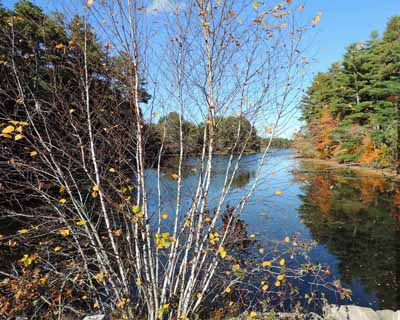Friends of Myles Standish State Forest
East Head Reservoir Eco Tour

Gray Birch

Welcome to "Birch Alley." For the next several hundred yards, you will see gray birch (Betula populifolia) along the shore. Known for the beautiful light-colored bark, gray birch is often confused with white birch (more on that later).
The earliest birch fossils have been found in the Klondike area of Alaska from about 49 million years ago. Since birches have been growing on the North American landmass for so long, they are considered to be natives.
Birch trees prefer moist woodlands near bodies of water in cool, temperate climates. They have shallow, sprawling roots that often break through the surface of the ground. The ready source of water means birch trees can grow quickly, and may form multiple trunks from the same root system.
Gray Birch at East Head

Multiple Trunks from one root
Birches produce both male and female flowers, called catkins, on the same tree. Plants that do this are called "monoecious." (see image below).

Gray Birch Catkins
The singular male catkins hang below, while the female catkins are upright. The catkins grow during the summer and fall but are held on the tree during the winter. In winter, deciduous trees store sap made by last summer's photosynthesis in the roots. In springtime, the birch trees pump that sap up to the branches. While the sap is on the way up, the birch trunks can be tapped to make a sweet syrup, about 50% fructose and 50% glucose. Once at the twiglets, the sugar is burned (cellular respiration) and the energy released is used to grow leaves for more photosynthesis. The species name populifolia means leaves that look like the leaves of quaking aspen (Populus tremuloides), not so much because they look alike, although they are quite similar, but for the way the leaves of both species often shimmy and shake in gentle fall breezes.
//OOPS THIS IS THE WHITE BIRCH CATKIN //WE NEED THE GRAY BIRCH ONE!Gray Birch leaves

Aspen Leaves

Leaves turn bright yellow in the fall before these deciduous trees lose their leaves.
Springtime Pollination
The energy from the ascending sap also animates last summer's male and female catkins, which lengthen and mature. The male catkins release millions of grains of very light pollen, which may drift for up to 20 miles.
Birch pollen allergy is not uncommon but manifests itself in an unusual way. Does your mouth itch when you eat apples, peanuts, celery, pears and others? You may have oral allergy syndrome. This is an allergy to birch pollen, but similarities with a variety of other plants stimulates the response. See your allergist.
Once wind-fertilized, the female catkins develop and store the mature seeds called nutlets, which are released from October through the winter.
Nutlets Look Like Soaring Birds.
Gray Birch Nutlets

- Sue Pike (seacoastonline.com)
Birches are Pioneers
If you walk along birch alley in winter, watch for these distinctive seeds which blow on the wind and may be pushed along the snow. The seeds are so light that they may be blown long distances. Since the seeds have soft shells (unlike an acorn), birches are often the first trees to sprout after a fire or other disturbance. They are thus considered a pioneer species. It is likely that the trees along Birch Alley sprouted shortly after the last fire on this shore. Once established, gray birches live only a short time in tree terms, fifty to sixty years. The copse will re-seed itself for a few hundred years before nearby conifers and eventually other deciduous trees overshadow them in the process of succession. Unless, of course, a fire occurs which will re-set succession.
Distinctive Mushrooms
The last fire around this side of the lake was a long time ago. As a result many of the pioneer birch trees are dying, dead or already down. Look for the birch polyphore mushroom (Fomitopsis betulina) that lives in small wounds and crevasses on birch trees for years. It becomes active when the tree weakens and often overwhelms and causes the death of the tree.
Birch Polyphore Mushrooms

- photo by Pye- East Head Trail
Also called Horses Hooves, Turkey Tail or Bacon Fungus
Can you tell the difference? Gray vs. White Birch
Note: Few white birch have been found in the forest.
Size: While gray birch may grow up to thirty feet tall, white birch may grow twice that tall.
Bark: the best way to tell the difference.
White birch (Betula papyrifera) (also called paper birch) is known for its white bark, which easily peels into paper-like pieces. Gray birch bark does not easily peel. White birch bark was used for Native American canoes.
Gray Birch Bark

White Birch Bark

Leaves:
Gray Birch Leaves

White Birch Leaves

White birch leaves are rounder and less toothed than gray birch.
Birch relative is world’s biggest organism.
Pando: the Monster Quaking Aspen
 -wiki
Quaking Aspen (Polulus tremuloides)
-wiki
Quaking Aspen (Polulus tremuloides)
Similar to birch, the quaking aspen can produce multiple trunks from the same root system. This tree has been named "Pando" and is estimated to be several thousand years old and weigh 6000 tons.
All line drawings by: Patricia J. Cassidy